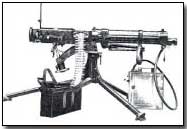Encyclopedia - Vickers Gun
 The Vickers Gun, closely modelled on the
Maxim Gun,
comprised the British Army's standard heavy
machine gun at the start of the
First World War, following its formal adoption in 1912.
The Vickers Gun, closely modelled on the
Maxim Gun,
comprised the British Army's standard heavy
machine gun at the start of the
First World War, following its formal adoption in 1912.
Water cooled - via a jacket around the barrel which held approximately one gallon - the Vickers was loaded from a 250-round fabric belt mounted on a tripod. A rubber hose leading to a container condensed steam from the jacket as a means of minimising water wastage.
The gun used standard rifle 0.303-inch ammunition and weighed a little under 20kg; it was thus lighter than both the original Maxim Gun and the German Maschinengewehr 08. It fired some 450 rounds per minute; after some 10,000 rounds had been fired the gun barrel invariably required replacement.
Despite this the Vickers was still considered unwieldy as a battlefield infantry weapon, and could not be readily transported from site to site without great effort. The gun itself was usually operated by a team of six men.
Although the predominant British machine gun in 1914 and for much of 1915 - it remained so for British imperial troops sited on far-flung battlefields, innovations in machine gun design invariably showing up first on the Western Front - it was gradually replaced from late 1915 onwards by the lighter Lewis Gun. Even so it gained a reputation as the 'Queen of the battlefield' by men of the British Machine Gun Corps founded in October 1915 and remained in use long into the twentieth century.
As a measure of the effectiveness and reliability of the weapon, during the British attack upon High Wood on 24 August 1916 it is estimated that ten Vickers fired in excess of one million rounds over a twelve hour period.
The Vickers was also used - after interrupter gear adaptation - by British and French airmen and in tanks.
The Parados was the side of a trench farthest from the enemy.
- Did you know?
